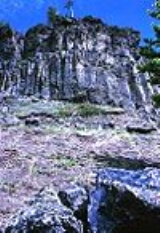
Obsidian Cliff
Encyclopedia
Obsidian Cliff, also known as 48YE433, was an important source of lithic
materials for prehistoric peoples in Yellowstone National Park
near Gardiner, Montana
. The cliff was named by Philetus Norris
, the second park superintendent in 1878. It was declared a National Historic Landmark
in 1996.
The cliff was formed from thick rhyolite lava flow that occurred about 180,000 years ago. The vertical columns are cooling fractures that formed as the thick lava flow cooled and crystallized. The flow consists of obsidian, a dark volcanic glass. The obsidian
is most abundant at the base of the cliff and slowly tapers off to larger concentrations of pumice at the top. Obsidian from this site was first quarried here about 12,000 years ago. Early natives of North America placed a high value on the obsidian that came from this cliff as well as other similar obsidian deposits in the area because numerous tools could be fashioned from obsidian - most popularly knives, spear/arrow tips, and other sharp edged objects. In fact, obsidian was so sought after in early America (before the time of Columbus) that it was traded as far away as Mexico and Guatemala, and Ohio and Canada.
Many studies have been done on the composition of the obsidian from Obsidian Cliff and how the obsidian from Obsidian Cliff was distributed. This research has provided evidence of the direction and extent of prehistoric trade networks.
It is located about 13 miles (20.9 km) south of Mammoth Hot Springs
, on the east side of the Mammoth-Norris section of the Grand Loop Road
. The Obsidian Cliff Kiosk
, just north, is also listed on the National Register.
Lithic
Lithic may refer to:*a stone tool*Lithic analysis*Lithic stage*Lithic core *Lithic reduction *Lithic technology *Lithic flake *Lithic fragment...
materials for prehistoric peoples in Yellowstone National Park
Yellowstone National Park
Yellowstone National Park, established by the U.S. Congress and signed into law by President Ulysses S. Grant on March 1, 1872, is a national park located primarily in the U.S. state of Wyoming, although it also extends into Montana and Idaho...
near Gardiner, Montana
Gardiner, Montana
Gardiner is a census-designated place in Park County, Montana, United States, along the 45th parallel. The population was 851 at the 2000 census....
. The cliff was named by Philetus Norris
Philetus Norris
Philetus W. Norris was the second superintendent of Yellowstone National Park and was the first person to be paid for that position.- Early life :...
, the second park superintendent in 1878. It was declared a National Historic Landmark
National Historic Landmark
A National Historic Landmark is a building, site, structure, object, or district, that is officially recognized by the United States government for its historical significance...
in 1996.
The cliff was formed from thick rhyolite lava flow that occurred about 180,000 years ago. The vertical columns are cooling fractures that formed as the thick lava flow cooled and crystallized. The flow consists of obsidian, a dark volcanic glass. The obsidian
Obsidian
Obsidian is a naturally occurring volcanic glass formed as an extrusive igneous rock.It is produced when felsic lava extruded from a volcano cools rapidly with minimum crystal growth...
is most abundant at the base of the cliff and slowly tapers off to larger concentrations of pumice at the top. Obsidian from this site was first quarried here about 12,000 years ago. Early natives of North America placed a high value on the obsidian that came from this cliff as well as other similar obsidian deposits in the area because numerous tools could be fashioned from obsidian - most popularly knives, spear/arrow tips, and other sharp edged objects. In fact, obsidian was so sought after in early America (before the time of Columbus) that it was traded as far away as Mexico and Guatemala, and Ohio and Canada.
Many studies have been done on the composition of the obsidian from Obsidian Cliff and how the obsidian from Obsidian Cliff was distributed. This research has provided evidence of the direction and extent of prehistoric trade networks.
It is located about 13 miles (20.9 km) south of Mammoth Hot Springs
Mammoth Hot Springs
Mammoth Hot Springs is a large complex of hot springs on a hill of travertine in Yellowstone National Park adjacent to Fort Yellowstone and the Mammoth Hot Springs Historic District. It was created over thousands of years as hot water from the spring cooled and deposited calcium carbonate...
, on the east side of the Mammoth-Norris section of the Grand Loop Road
Grand Loop Road Historic District
The Grand Loop Road Historic District encompasses the primary road system in Yellowstone National Park. Much of the system was originally planned by Captain Hiram M. Chittenden of the US Army Corps of Engineers in the early days of the park, when it was under military administration...
. The Obsidian Cliff Kiosk
Obsidian Cliff Kiosk
The Obsidian Cliff Kiosk is a small structure that shelters an interpretive exhibit in Yellowstone National Park at Obsidian Cliff. The kiosk was built in 1931 as part of an effort to provide interpretive exhibits along the park's Grand Loop Road. In common with the Fishing Bridge Museum, Madison...
, just north, is also listed on the National Register.
External links
- Obsidian Cliff National Historic Landmark at the Wyoming State Historic Preservation Office

